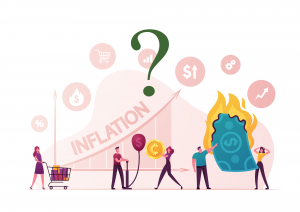
By Richard Morey
May 2023
 Misconceptions
Misconceptions
Dr. Lacy Hunt & Dr. John Hussman are the two greatest monetary economists in our country (a view widely held in the world of economics). Last week Dr. Hussman put out a report titled: Fabricated Fairy Tales and Section 2A. In this article he proves that pretty much everything we’ve been hearing about the causes of inflation – and how to stop it – have no basis whatsoever in fact.
Specifically, he shows that both the rate of unemployment and interest rates have no correlation to what inflation does next. Interest rates can go up or down, and unemployment can rise or fall, but this tells us nothing about whether inflation is likely to therefore continue to rise, or fall. These are independent variables, yet the media tells us a hundred times a day that raising interest rates will lead to more unemployment, the economy will then contract, and inflation will fall. No, no and no (or rather maybe, maybe, and maybe) is what the data says. Hussman concludes this part by stating:
“Examining all this data may leave you thinking “Wait, what?!? How is it possible that there’s no basis in the data for all of these ideas that people take as common knowledge – from the Phillips Curve; to the supposed ‘economic support’ provided by quantitative easing; to the effect of rate hikes on unemployment and inflation? How is it possible that people who do this for a living can keep repeating wholly unsupported cause-and-effect arguments without even taking the initiative to operate a basic scatterplot?
Welcome to my world.
My impression is that there are two reasons these misconceptions survive. First, I really do believe that, particularly in the face of uncertainty, people find comfort in having a common framework to discuss and explain their world, even if that framework is incorrect. Second, there’s a natural tendency for investors to draw cause-and-effect inferences from the most extreme examples, using them to confirm their framework even when different factors are actually responsible.”
Dr. Hussman’s data was an eye-opener for me, as it wiped away some of the confusion caused by listening to the Fed and a hundred other economists on inflation. In addition, I was guilty of making the mistake outlined above which was to look at several extreme economic examples and then assume these prove the relationship between employment, interest rates and inflation.
Instead, what we find is that one factor controls all three of the other variables, i.e. inflation, employment, and interest rates. That factor is called severe economic contraction, especially when combined with large debt and stock market losses. As Dr. Hussman says:
“For example, inflation fell substantially both during the Depression and during the global financial crisis. Those declines provide anecdotal evidence that recessions and unemployment result in lower inflation. The problem is that both of these factors have rather weak effects on inflation in themselves. Instead, declining inflation is better correlated with measures of risk-aversion, provided the financial strains are extreme, for example, spiking credit spreads and steep equity market losses.
Specifically, when investors become very risk-averse, risk-free liquidity becomes a desirable asset rather than an “inferior” one. When investors become risk-averse, the perceived “value” of Fed liabilities – dollars – becomes very high, so people are willing to exchange lots of goods and services (and as it happens, risky securities) for cash. That produces declining inflation, hand-in-hand with financial market losses.”
This is the key point for us today – yes, inflation will indeed come tumbling down, if and when we have a credit crisis or “spiking credit spreads.”
What Actually Causes Inflation
Since a debt crisis is likely what we’re facing today, we suspect inflation will soon be yesterday’s worry. Before moving on to exploring how inflation is indeed likely to be gone later this year, we’ll take just a moment to share what Dr. Hussman (and the data) says are the real causes of inflation. There are two primary causes:
-
1. When the supply of money in the economy, relative to the size of that economy, is substantially higher than average, you have the primary ingredient needed for inflation to take off. Due to the Fed’s ten+ years of quantitative easing, the amount of money in the economy is the largest we’ve seen since… forever, with over $8 trillion additional money sitting in the banks as a result. This is nearly double the normal rate, and every dollar appeared every time the Fed purchased a bond from the banks. The Covid relief measures led to another massive surge of money into our banking system.
-
2. The other ingredient needed to cause inflation is purely psychological. When consumers feel inflation is going to rise over the next year, that feeling is the single best predictor of inflation and has an indispensable causal relationship. Without it, inflation can’t become a problem; with it, inflation can get wild.
Of course, these are the two required elements, but they don’t necessarily catch fire until exogeneous forces are added to the brew. In our case, the entire world saw supply chain disruptions leading to shortages, plus nearly the entire developed world saw their governments borrow and distribute massive amounts of money to their citizens and/or companies during the Covid pandemic. Followed by a war disrupting world oil and food supplies. This was indeed a great recipe to create inflation!
Put it all together, and we see that, in the U.S., the amount of money in our banking system went through the roof by the end of Covid. That’s what causes inflation. As soon as too much money starts to get out into the economy, psychology takes hold and people start expecting more and more price increases. This is when inflation starts to get out of hand.
Looking at the real causes of inflation tells us how to combat it. The golden key is the first statement about the amount of money in your economy relative to its size. The Fed can and does have control over the money supply. Dr. Hussman argues that inflation was defeated by Chairman Volcker in the early 1980s exclusively by focusing upon and controlling the money supply. Inflation is caused by too much money chasing too few goods and services. Therefore, you shrink the money supply and inflation dies.
Is the Fed Shrinking the Money Supply?
I’m not sure how much the Fed is actively trying to lower the money supply, but unbeknownst to all newscasters, the money supply is falling further and faster than any time since 1947.
There are two main measures of the money supply, M1 which includes money in circulation plus checkable deposits in banks, and M2 includes M1 plus savings deposits (less than $100,000) and money market mutual funds.
The more narrow M1 has been falling every month for the last year and is now down 8.3%. M2 fell 1.2% last month and 4% over the last year. These are unprecedented falls. Since an expanding money supply is necessary for inflation, unless the flow of money starts increasing, look for inflation to fall.
 Banks
Banks
That flow of money must come from bank lending. Three weeks ago I heard one of the Fed Governors on television saying they weren’t yet seeing any slowdown in bank lending after the failure of Silicon Valley Bank. The next article I read was a report just released by the Dallas Fed showing bank lending falling through the floor. Since that time, all the new data agrees with the Dallas Fed.
May 1st was an unusual day for banking in the US. First, JP Morgan purchased First Republic Bank. The CEO of JP Morgan, Jamie Dimon, announced that this was the end of the banking problems – essentially saying “nothing to see here folks, move along.” The stock market agreed and took the failure of one of the largest banks in the country as a positive? Welcome to my world!
This morning the winds are blowing the opposite direction. It turns out Mr. Dimon may have been slightly premature, as two more large regional banks look to be experiencing the beginning of two more bank runs. Like I’ve known for many years, when a bank stock falls over 20% for more than two days in a row, that bank will no longer exist on either the third or fourth day. Through the advent of banking on our phones, bank runs are now happening much faster than ever.
Here’s what Dr. Hussman says about our banking situation:
“As Silicon Valley Bank discovered, the problem is once depositors ask for their money back, the actual market value of the assets suddenly matters. That’s also true of Ponzi schemes. When you see the exploding quantity of assets classified by commercial banks as “held to maturity,” you’re seeing loose FAS 157 accounting standards in action. Commercial banks now hold $2.8 trillion in held-to-maturity securities. By comparison, total bank capital is $2.2 trillion. Banks, in aggregate, can tolerate a reasonable amount of losses, and of course, classifying assets as held-to-maturity allows those losses to go unreported. Still, none of this quiet Ponzification of the banking system would be necessary if not for a decade of misguided Fed policy.”
That was just round one. Buckle up.
